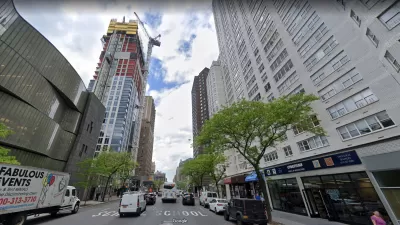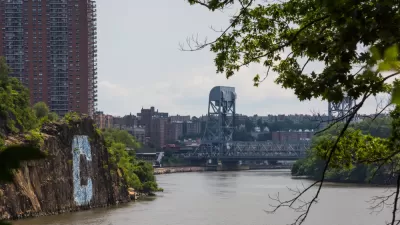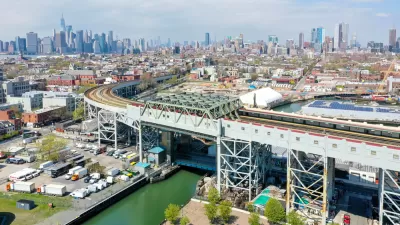New York's 1916 zoning code would not have allowed 40 percent of buildings in Manhattan to be built today, according to a recent analysis. It also turns 100 on August 27 of this year.
"New York’s zoning code was the first in the country, meant to promote a healthier city, which was then filling with filthy tenements and office towers," write Quoctrung Bui, Matt A.V. Chaban, and Jeremy White for The New York Times' "Upshot."
That assessment is reinforced in the introduction of a May 20 Wall Street Journal book review, "In Praise of Urban Sprawl," regarding Joel Kotkin's The Human City: "The New York Times in 1898 spoke of 'densely crowded quarters' and 'inmates . . . huddled together in their cramped hutches like rabbits',” writes Shlomo Angel. Zoning codes sought to improve city living conditions without having to resort to the sprawl that Kotkin praises. [See book review of "The Human City" by Planetizen contributor, Josh Stephens.]
"Since it was approved in 1916, the ever-evolving, byzantine code has changed many times to suit the needs of a swollen metropolis," write Bui, Chaban, and White.
Just in March, the administration of Mayor Bill de Blasio won approval for a vast citywide plan that would encourage sleeker, more affordable developments. As the zoning code enters its second century, it is worth considering the ways it has shaped the city; whether and where it is still working; and how it might be altered so the city can continue to grow without obliterating everything New Yorkers love about it.
The 40 percent finding comes from an analysis made by Quantierra, "a real estate firm that uses data to look for investment opportunities."
Many buildings in distinctive Manhattan neighborhoods like Chinatown, the Upper East Side and Washington Heights could not be erected now: Properties in those areas tend to cover too much of their lots (Washington Heights), have too much commercial space (Chinatown) or rise too high (the Upper East Side). Areas like Chelsea, Midtown and East Harlem, on the other hand, would look much as they do already.
“Look at the beautiful New York City neighborhoods we could never build again,” said Mr. Stephen Smith, a co-owner of Quantierra. “It’s ridiculous that we have these hundred-year-old buildings that everyone loves, and none of them ‘should’ be the way they are.”
The reporters describe the various attractive buildings, with photos, that predate the 1916 zoning code, and the reasons why city planners altered the zoning code to make those buildings illegal. They consider the downside of the ever-more restrictive zoning codes. Explore Manhattan on this interactive map by placing your browser over areas and see which of four reasons would prevent existing buildings from being constructed.
"In honor of the code’s 100th anniversary, the Municipal Art Society of New York has called on City Hall to consider overhauling the code in a way that would make it intelligible to all," write Bui, Chaban, and White. See related Planetizen post in 2011.
“To understand zoning, you have to have a law degree, it’s so convoluted and so dense,” Mike Ernst, director of planning at the civic group, said. “The whole process of how buildings get built these days is so confusing and opaque to people. There really should be more transparency, so people can have an understanding of what the future holds for their city.”
FULL STORY: 40 Percent of the Buildings in Manhattan Could Not Be Built Today

Maui's Vacation Rental Debate Turns Ugly
Verbal attacks, misinformation campaigns and fistfights plague a high-stakes debate to convert thousands of vacation rentals into long-term housing.

Planetizen Federal Action Tracker
A weekly monitor of how Trump’s orders and actions are impacting planners and planning in America.

Chicago’s Ghost Rails
Just beneath the surface of the modern city lie the remnants of its expansive early 20th-century streetcar system.

Bend, Oregon Zoning Reforms Prioritize Small-Scale Housing
The city altered its zoning code to allow multi-family housing and eliminated parking mandates citywide.

Amtrak Cutting Jobs, Funding to High-Speed Rail
The agency plans to cut 10 percent of its workforce and has confirmed it will not fund new high-speed rail projects.

LA Denies Basic Services to Unhoused Residents
The city has repeatedly failed to respond to requests for trash pickup at encampment sites, and eliminated a program that provided mobile showers and toilets.
Urban Design for Planners 1: Software Tools
This six-course series explores essential urban design concepts using open source software and equips planners with the tools they need to participate fully in the urban design process.
Planning for Universal Design
Learn the tools for implementing Universal Design in planning regulations.
planning NEXT
Appalachian Highlands Housing Partners
Mpact (founded as Rail~Volution)
City of Camden Redevelopment Agency
City of Astoria
City of Portland
City of Laramie





























